Puppy4中文手册(翻译中……)
说明:Puppy Linux 4.0的英文(日语、德语、西班牙语)手册已出,为方便大家查看学习,特将英文手册先复制粘贴到这儿(翻译工作量较大,只能一步一步来啰!)大部分章节内容与Puppy3.01手册大同小异,可直接查看gsxlm翻译的Puppy Linux 3.01使用手册,未翻译章节已打上“★”号。如果想完整系统地学习Linux,尝尝 鳥哥的Linux私房菜 繁體版或简体版也不错!
由于大家都是业余爱好者,时间和精力有限,请有一定英语基础的朋友一起来翻译,只求意到,不求最好,翻译内容可用跟帖形式发布,谢谢!
Puppy Linux是一个非常智能的Linux发行版,它是由澳大利亚教授Barry Kauler编制的。他刚刚开始退休生活。他制定了一种类似Windows的Linux ,这种linux包含了所有重要的程序。而且它小到足以在早期的电脑的内存中运行。Puppy 几乎能在所有的硬件上运行。它易于操作,可以非常容易地适合个人偏好。许多志愿者不断为它编写软件。Puppy 有一个全球性的群体,每天24小时用英语通过互联网进行交流。
前言:
这本手册供想熟悉PuppyLinux的初学者和Linux用户使用。在互联网上有各种各样的信息,你可以到Puppy网站上去浏览。这本手册概括了最重要的资料,帮助Puppy 初学者迈开第一步。
如何使用手册:
菜单条目和按钮都用""括起来表示,子菜单用垂直线分开。例如:"Menu | Shut Down | JWM restart"的意思是,你先点击按钮"Menu" ,然后在出现菜单的菜单上单击"Shut Down" ,最后点击"JWM restart" 。
在手册中字母X是用来表示一个数字。例如/dev/hdax意味着你必须写成/dev/hda1,/dev/hda2或/dev/hda3——至于写成哪个数字要看你的电脑的具体情况。
对控制台"shell",可以运行"Menu | Run | Rxvt terminal emulator"程序。
英文原文:
Introduction
This manual will appeal to Linux beginners and Linux users, who would like to become acquainted with Puppy. This manual summarizes the most important information for Puppy beginners and explains the first steps with Puppy.
How to use the manual:
Menu entries and buttons are set in "", submenus are separated by vertical lines. Example: "Menu | Shut Down | JWM restart" means, that you first click on the button "Menu", than (at the appearing menu) on the headword "Shut Down" and finally on the headword "JWM restart".
In the manual the letter x is used as a substitute symbol for a number. For example /dev/hdax means that you have to write /dev/hda1, /dev/hda2 or /dev/hda3 - just use what suits your computer.
With the term "shell" the program "Menu | Run | Rxvt terminal emulator" is meant.
附:gsxlm翻译的Puppy Linux 3.01使用手册索引:
Puppy 4.0 中文手册索引:
如何获得Puppy(How to get Puppy)
你可以从ibiblio.org这个网站得到Puppy Linux。把最新版本Puppy-3.xx-seamonkey.iso(如Puppy-3.01-seamonkey.iso)保存到你的硬盘。这个文件的大小约100 MB。为了确保您下载了一个真正的原始文件,你检查ISO文件的MD5码是否与相关文件Puppy-3.xx-seamonkey.iso.md5.txt(如Puppy-3.01-seamonkey.iso.md5.txt)中的相符。
在Linux操作系统中:
打开一个shell然后进入你保存上述两个文件的目录,输入以下命令:md5sum Puppy - 3.01 - seamonkey.iso你会得到一个校验结果。用一个文本编辑程序打开文件Puppy-3.01-seamonkey.iso.md5.txt 。比较两个值是否相同。
在Windows环境中:
下载的DOS程序md5sum.exe 。打开DOS命令窗口,点击"开始|运行" ,打开运行窗口,输入以下命令:CMD

现在打开了一个DOS窗口。


进入你保存下载的两个文件的目录,如:
C:/Puppy。输入以下命令:c: cd \ cd puppy dir *.*

现在,你应该能看到Puppy文件。输入命令:
md5sum -c puppy-3.01-seamonkey.iso.md5.txt你应该得到一个"OK" 。
接着把ISO文件(我们以Puppy-3.01-eamonkey.iso为例)刻录成光盘。如何刻录光盘,请查看你的CD刻录软体的使用手册。初学者往往直接把ISO文件作为一种数据文件复制到光盘上,这是不行的。通常光盘刻录软件有一个特殊的选项,是专门用来把ISO文件刻录成光盘的。您可以用文件管理器来查看你的光盘是否正确刻录。如果你看到的文件中有
image.gz或vmlinuz.gz,说明你刻对了。如果你看到的文件是Puppy-3.01-seamonkey.iso,说明你没有刻对。How to get Puppy
You can get Puppy Linux from ibiblio.org. Save the current release puppy-4.xx-seamonkey.iso (e.g. puppy-4.00-seamonkey.iso) on your harddrive. The filesize is about 88 MB.
To make sure that you downloaded a genuine original file, you can compare the checksum of the ISO file with the associated file puppy-4.xx-seamonkey.iso.md5.txt (e.g. puppy-4.00-seamonkey.iso.md5.txt). Download this file as well.
Within Linux:
Open a shell and change into the directory, in which you stored the two files. Enter the following command:
md5sum puppy-4.00-seamonkey.iso
As a result you get the checksum. Open the file puppy-4.00-seamonkey.iso.md5.txt with a text program (e.g. abiword). The two checksums should be identical.
Within Windows:
Download the DOS-Program md5sum.exe. To open a DOS-Box click on "Start | Run". This opens an input window, into which you enter the following command:
cmd

Now you get a DOS-Box.

Change into the directory, in which you stored the two files, e.g. C:/Puppy. Enter these commands:
c:
cd \
cd puppy
dir *.*

Now you should see the Puppy-files. Enter the command:
md5sum -c puppy-4.00-seamonkey.iso.md5.txt
You should get an "OK".
Subsequently you burn the ISO file (in our example puppy-4.00-seamonkey.iso) on CD. To burn an ISO file on CD, consult the manual of your CD-burning software. Beginners sometimes copy the ISO file simply as a data-file on CD, which doesn’t work. Usually the CD-burning software has a special menu option for burning an ISO file on CD. You can verify whether you burned the CD correctly by looking at the CD with the file manager (e.g. Windows Explorer). If you see files as "image.gz" or "vmlinuz.gz" everything is OK. If you see the file "puppy-4.00-seamonkey.iso" this is incorrect.
Tip:
Create a second, identical Puppy CD as a backup copy, in case the original CD becomes corrupted.
如何运行Puppy(How to run Puppy)
How to run PuppyA great advantage of Puppy Linux is that Puppy doesn't have to be installed. You can run Puppy directly from the CD, without affecting your operating system. Alternatively you can install Puppy on a harddrive or a USB stick.
How to run Puppy the very first time
First you must set up the boot sequence in the BIOS. If you do not know how to get into the BIOS-setup, consult the computers manual. Usually you press one of the following keys immediately after switching on the PC: ESC, one of the function keys F1 to F12 or the delete key. At the BIOS-setup you change the boot sequence so that the CD-ROM drive is first and the harddrive is second. Close the BIOS-setup and store the settings.
The PC then usually reboots. Immediately insert the Puppy CD into the CD-ROM drive. If you are too slow your old operating system starts. In this case keep the CD inserted in the CD drive and start the PC again.
Now Puppy should start. During the starting procedure you are requested to choose your country. Navigate with the cursor keys downward to your country. Then strike the return-key. Thereafter a further window (Puppy video Wizard) appears, "Xorg" is already highlighted. Press the return-key. Wait some seconds till the next window (Puppy video Wizard) appears. There you navigate with the cursor keys to your screen (LCD panel = flat screen, CRT = standard monitor) and resolution. Then strike the return-key. After some seconds the Puppy desktop appears.
Should Xorg not work on your computer, choose Xvesa. A few seconds later, the Puppy desktop will be displayed using a resolution of 640 x 480 pixels. If you wish to use an even higher resolution choose e.g. 1280x1024x24 and click on the button "Change".

After some seconds the Puppy desktop appears again. Click on the OK-button.

Unfortunately, with Xvesa you will have to adjust the keyboard layout if you are not using a US keyboard.
Puppy was loaded completely into RAM. Your old operating system is not touched, so that you can look safely at Puppy Linux. Now you can take the CD out of the CD drive, unless you do not have enough ram, in which case Puppy will not allow the CD to be ejected.
If you terminate Puppy you are asked whether you want to store the settings (and your personal files) in a file named pup_save.2fs on a harddrive "SAVE TO FILE" or CD-ROM "SAVE TO CD". (you can change between the options with the tab-key). If you do not want to save the settings mark "DO NOT SAVE" and press the return-key.
If you would like to store the settings (and your personal files) you are asked on which harddrive this should happen.
Boot-Options
When Puppy boots it offers you some boot-options. If you do not enter anything, Puppy is loaded after some seconds into RAM. When starting Puppy automatically looks for a previously stored pup_save.2fs-file. If this file doesn't exist yet, you are asked for the keyboard map and the screen resolution.
With the boot-option
puppy pfix=ram
you have the option to start Puppy into RAM without your pre-saved-settings and without your personal files even if a pup_save.2fs-file already exists. This boot option is very useful and is used in this manual a few times. The other boot-options are normally not needed.
How to save the settings and your personal files
So that Puppy can store all settings and your personal data, a file named pup_save.2fs is saved. I recommend a size of 512 MB for this file. This is big enough for further programs and can be backed-up on CD-ROM (note: if you want to backup the file on a USB stick, it must have a storage capacity of 1 GB). Puppy can store the pup_save.2fs-file on many different filesystems including FAT and NTFS as used by windows. (note: USB sticks and external harddrives are usually formatted with a FAT32-filesystem, so that they can be used without problems). Windows XP-users normally have a NTFS-filesystem only. There are two options for you to store the pup_save.2fs-file as well:
(1) Save the file on an external harddrive or USB-stick.
(2) Make the NTFS partition smaller and create one or more further partition with FAT32-filesystem and ext2/ext3-filesystem.
If you intend to use Puppy durably you should select the second alternative. This alternative has many advantages.
★如何安装Puppy(How to install Puppy)
如何安装Puppy友情提示:Windows用户如果没有特别需求,推荐在windows下使用pup2usb将puppy直接安装到硬盘或U盘中,这是最简便的精简(frugal)安装方式。这种pup2usb方法无需刻盘,不需要对硬盘进行专门分区,直接安装puppy到硬盘的NTFS或FAT32分区即可。(实际安装过程只是复制三到四个puppy专用文件到windows分区的puppy文件夹下,再在windows启动菜单里添加puppy启动项)
如果你不喜欢每次用光盘启动Puppy,您可以安装Puppy到硬盘中。这就需要一些准备工作。
硬盘,分区和文件系统
一个硬盘可以分为一个或多个分区。如果您要创建几个分区的硬盘,每个分区就好象操作系统中的一个硬盘。换句话说:尽管你只有一个硬盘在电脑上,你会在Windows或Linux中看到好几个(虚拟)硬盘。Windows会给每个分区指定盘符(包括软驱和CD/DVD驱动器)。通常A是软盘驱动器,C是硬盘(第一个分区),D是CD-ROM驱动器,E是硬盘(第二分区),F是硬盘(第三分区),等等。每个分区都有自己的文件系统,Windows通常使用NTFS(在WinXP中)或FAT32(在Win98,Win95中)。
在Linux下(第一个)硬盘的地址是/dev/hda或/dev/sda。如果您的电脑有第二个硬盘,地址为/dev/hdb或/dev/sdb。分区从1开始按顺序编号。您的硬盘分区地址是/dev/hda1(相当于Windows中的C盘),/dev/hda2(相当于Windows中的E盘),/dev/hda3,等等。Linux可以在不同的文件系统中工作,如ext2,ext3和ReiserFS。这些文件系统是Windows无法读取的。此外,Linux也可以在Windows文件系统中工作。利用FAT32在Windows和Linux之间交换文件是一个不错的办法。
How to install Puppy
If you don't feel like booting Puppy from CD-ROM all the time, you can install Puppy to hard disk. This requires some preparation.
Harddrives, partitions and filesystems
A harddrive can be divided in one or more partitions. If you create several partitions on a harddrive, each partition appears like a harddrive in the operating system. In other words: although you have only one harddrive in your PC, you will see several (virtual) hard-drives with Windows or Linux. Windows designates the harddrives (as well as the floppy disk drive and CD/DVD drive). In Windows they will be identified with letters. Usually A designates the floppy disk drive, C the harddrive (first partition), D the CD-ROM drive, E the harddrive (second partition), F the harddrive (third partition) and so on. Each partition has its own file system, Windows normally uses NTFS (Windows XP) or FAT32 (Win98, Win95).
With Linux the (first) harddrive is adressed as /dev/hda or /dev/sda. If your PC has a second harddrive, it is adressed as /dev/hdb or /dev/sdb. The partitions are sequentially numbered, starting with one. The partitions of your harddrive are adressed as /dev/hda1 (corresponds to the Windows C-partition), /dev/hda2 (corresponds to the Windows E-partition), /dev/hda3 and so on. Linux can work with different file systems such as ext2, ext3 or ReiserFS. These file systems are not readable by Windows. In addition Linux can work with Windows filesystems too. Due to this option a FAT32-Partition is ideal to exchange files between Windows and Linux.
整理磁盘碎片(Defragment your hard disk)
Defragment your hard diskBefore creating new partitions on your hard drive, you shoulddefragment the drive so that all data is stored at the beginning of theexisting partition. Here is how to do it:
Start up Windows.
First, backup your files to CD-ROM, DVD, or an external hard drive.Also remember to backup your Internet link collection (Favourites) andyour e-mails. If your data is encrypted, it is advisable to decrypt itbefore backing it up. This protects you from data loss becausemodifying hard drive partitions always carries the risk of data loss.
Next, start the Disk Defragmenter program under Windows. The programis located at "Start | All Programs | Utilities | System Programs |Disk Defragmenter". Select hard drive c:\ and click the "Check" button.



Click the "Defragment" button. Depending on the size of thepartition and the amount of data on it, this process can take a longtime (over an hour). If you have very large amounts of data, you canspeed up this process drastically by deleting your files after you havebacked them up (see the previous item) and restoring them once you aredone with the modifications. In this case, please make sure beforehandthat your backup is readable, otherwise there will be wailing andgnashing of teeth.

Click the "Close" button.

There is now space on the harddisk for additional partitions.
Shut down Windows.
创建分区(Creating partitions)
Creating partitionsNow you should plan the layout of your hard disk partitionsregarding file system and size. I recommend creating three or fourpartitions in addition to the Windows partition. The following exampleassumes you have exactly one Windows partition (drive letter C). Yourhard disk would then look like this:
First partition: NTFS or FAT32 (Windows)
Second partition: ext2 or ext3 (this is where Puppy will be installied to)
Third partition: Linux swap (for page files)
Fourth partition: FAT32 (for exchanging data between Windows and Linux)
Optionally, a fifth partition: ext2 or ext3 (Linux)
Windows will continue to reside on your first partition with all itsprograms and data. The second partition (recommended size about 1-2 GB)has a Linux file system (ext2 or ext3). This is the partition Puppywill be installed to. The third partition (exactly as large as yourcomputer's memory) will be a Linux swap partition that Linux can ...well, swap files to. The fourth partition has a FAT32 file system,which is recognized by both Windows and Linux. This partition(recommended size about 5 GB) is used for files that you want to accessfrom both Windows and Linux. If you want to manage large amounts ofdata under Puppy (e.g. music collection, pictures), you should create afifth partition with a Linux file system (ext2/ext3). This file systemcannot be accessed from Windows and is meant for Linux only.
To create the partitions, proceed as follows:
Start Puppy Linux from CD with the "pfix=ram" boot option.
Start the Gparted program: "Menu | System | Gparted partition manager".
First, shrink your Windows partition (NTFS file system). To do this, select the Windows partition /dev/hda1.

Click the "Resize/Move" button.

Reduce the "New Size" value until the "Free Space Following" fieldshows enough free space following for the new partitions. My testcomputer's hard disk has only 3 gigabytes; I am using half of that forthe mew partitions. You probably have a much larger hard drive so yourpartition sizes can be increased accordingly.

Then press the "Resize/Move" button.
Next, select "Edit | Apply All Operations" from the menu.

In the dialogue box that comes up, click the "Apply" button.



Click the "Close" button. You now have an "unallocated" area on your hard disk.
Select the line saying "unallocated" and click the "New" button.

Enter the size of the second partition in the "New Size" field. Thisis where Puppy Linux will be installed to. I recommend a size of 1 to 2gigabytes (i.e., 1024 to 2048 MB). Select ext2 from the "Filesystem"box and click "Add".

Again select the line saying "unallocated" and click the "New" button. (You can see where this is going.)

Enter the size of the third partition in the "New Size" field. Thispartition is to hold Linux's swap files as a Linux swap partition. Youshould make it as large as your computer's memory (RAM). With my testcomputer, this amounts to 128 megabytes (MB). Select linux-swap fromthe "Filesystem" box and click "Add".

Again select the line saying "unallocated" and click the "New" button.

Enter the size of the fourth partition in the "New Size" field.Thispartition is meant for shared access to files from Windows and Linux. Irecommend a size of about 5 gigabytes (5120 MB). Since my test computerdoes not have a large enough hard disk, I am using 396 megabytes (MB)as an example. Select FAT32 from the "Filesystem" box and click "Add".

Hint: if you want to create additional partitions (e.g., for verylarge files under Linux), repeat the process outlined aboveaccordingly. In this case, you may have to create so-called logicalpartitions. Please consult additional sources if you are unsure abouthow to do that.
To actually write the changes to disk, select "Edit | Apply All Operations" from the menu.

In the dialogue box that comes up, click "Apply".


Click the "Close" button.

Exit GParted.
系统安装(Installation)
InstallationThere are different ways to install Puppy:
Frugal Installation (Pupy CD image on hard drive)
Full Installation
Installation to a USB flash drive
Installation to a CF card
I recommend Frugal Installation, if you have 256 MB RAM or more. If you have less than 256 MB RAM you should choose Full Installation.
简化安装(Frugal Installation)
这里介绍的是如何用Puppy通用安装程序来简化安装Puppy,其实,用Pup2usb安装Puppy到硬盘或U盘,也是简化安装的最简便方式。Frugal Installation using Puppy Universal Installer
A Frugal Installation copies the image from the Puppy CD to the harddrive. At bootup, Puppy is loaded into your computer's memory (RAM)just as it is when you boot Puppy from CD, however, loading it from ahard drive is much faster. This way, Frugal Installation combines theadvantages of booting from CD-ROM (protection from malware) and a harddrive bootup (speed). Moreover, upgrading to a new Puppy version isvery simple - all you have to do is replace some files.
Start "Menu | Setup | Puppy universal installer". Choose whichmedium Puppy should be installed to. In this example, I chose theinternal hard drive.

If you have several hard drives, select one.

Next, click on the button next to the partition that you want Puppy to be installed to - /hda2 in this example.

In the dialogue box, click "OK".

You now have to decide whether you want a "Frugal" or a "Full" installation. In our example, click on the "FRUGAL" button.

Now you change the installation directory. Just click on the "OK" button.

The files are now copied from CD to the hard drive.
The installation is finished. In the next two dialogue boxes, click "OK".


Since you now have two operating systems on your computer (Windowsand Puppy Linux), you need a boot loader. The boot loader is the firstprogram executed after switching the computer on. It enables you tospecify which operating system should be started up. If Windows was theonly operating system on your computer up to now, you do not have aboot loader. Start the installation of the boot loader GRUB with "Menu| System | Grub bootloader config".
Select "simple installation" and click "OK".

In the next dialogue box, select "standard" and click "OK".

Now you have to specify where the GRUB boot loader should store itsfiles. These can only be written to a Linux file system partition.Thus, please specify one of the Linux (ext2 or ext3 file system)partitions you created (/dev/hda2 in the example). If you do not have aLinux file system partition yet, you need to create one.

Now you have to specify where the GRUB boot loader itself should beinstalled to. Select the Master Boot Record "MBR" and click "OK".

In the next dialogue box, click "OK".

The installation is complete. What remains to be done is toconfigure the GRUB boot loader so that Puppy Linux can be booted. Thisis how to do it:
Open the file "menu.lst". You will find this file in the /boot/grubdirectory of the partition you installed the GRUB files to (/dev/hda2in our example). For Linux newbies, I include detailed instructions onhow to find and open this file. More advanced users can skip ahead towhere menu.lst gets edited.
Start "Menu | Filesystem | Pmount mount/unmount drives" and click on the button "MOUNT" next to "/dev/hda2".

The button changes to "UNMNT".

Start "Menu | Filesystem | ROX-Filer file filemanager".
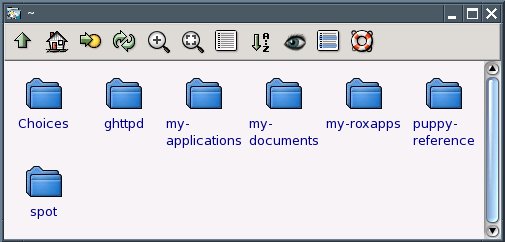
Right-click with the mouse and choose "Window | Enter Path".

Enter the following path next to "Goto: /mnt/hda2/boot/grub/

You are now at the folder /mnt/hda2/boot/grub/

Use the right mouse button to click on the file called "menu.lst".

From the context menu that pops up, select "File menu.lst | Open As Text".

You can now see the contents of the menu.lst file.

Edit the file at this point:

title Puppy Linux 4.00 frugal (on /dev/hda2)
rootnoverify (hd0,1)
kernel /puppy400/vmlinuz pmedia=idehd psubdir=puppy400
initrd /puppy400/initrd.gz
(Notice: depending on what medium you boot from, you have to set thepmedia parameter to one of usbflash, usbhd, usbcd, ideflash, idehd,idecd, idezip, satahd, scsihd or scsicd. If you did not install theGRUB files to the /dev/hda2 partition, you need to change therootnoverify parameter as well - partition number and Linux driveletter minus one, so if the GRUB files are on /dev/hdb3, make it"rootnoverify (hd1,2)".)
The bit you changed in the file should now look like this:
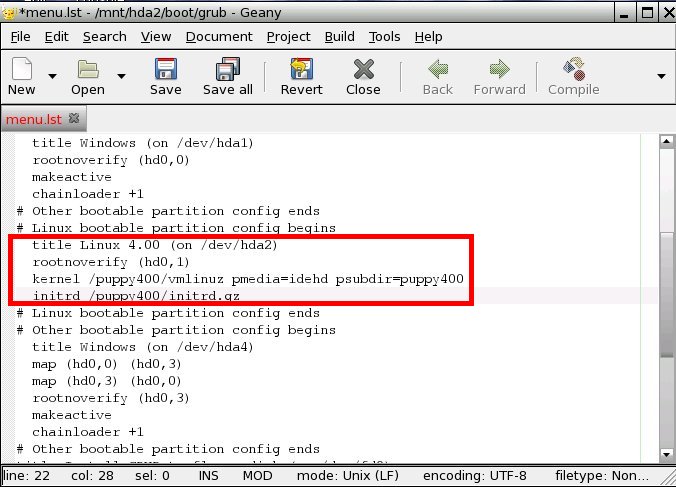
"Comment out", i.e. put a number sign (#) before each of the following lines:

It should now look like this:

All necessary changes have been made. The file should now look like this:

Save the file by selecting "File | Save" from the program's menu. Exit the text editor.
Close the ROX file manager.
Click on the button "UNMNT" next to /dev/hda2.

The button changes to "MOUNT".

Click on the button "QUIT".
Exit Puppy and reboot the computer: "Menu | Shutdown | Reboot computer".
When you reboot the computer, you will be asked whether you want tosave the "session" (i.e., all the configuration changes you made). HitReturn to select the entry "SAVE TO FILE", which is alreadyhighlighted.
Confirm the next dialogue (Warning) by hitting Return.
In the next dialogue, select the "hda2" partition with the cursor keys and press Return.
Now. you will be asked, if the file should get a special filename. Just press Return.
You will be asked whether you want a normal (unencrypted) or anencrypted save file. Select "NORMAL" with the cursor keys and pressReturn.
The next dialogue lets you choose a size for your save file. A filesize of 512 megabytes is usually sufficient. You can increase (but notdecrease) this size anytime from within Puppy. Pick the desired filesize with the cursor keys and press Return.
In the next screen you see a summary. Choose "Change Folder" and press return.
Next, you enter "/puppy400" as subfolder and confirm with return.
Again a summary is shown and if everything seems to be ok, choose "Yes, save" with the arrow keys, then press return.
Please be patient while the file is created.
Next you will be asked if Puppy 4.xx should test for serial devicesat each boot. Choose ""No" with the arrow keys and confirm with return.
Now you decide wether the system file pup400.sfs should be copiedover to the harddrive. Choose "Yes" with the arrow keys and confirmwith return.
Last not least the computer restarts automatically. Remove the PuppyCD from the drive before the shutdown is complete. Upon reboot the bootloader will show up. Choose ""Puppy Linux 4.00 frugal (on /dev/hda2)""with the arrow keys and confirm with return.
手动安装(Manual Installation)
Manual InstallationTo be able to use this option, a boot loader has to be installed on your computer. If there is no boot loader installed on your computer, I recommend doing so using the Puppy Universal Installer.
Boot Puppy fom CD with the "puppy pfix=ram" boot option.
Create a new directory "puppy400" onto a partition with a Linux file system (ext2/ext3) or a FAT32 file system.
Copy the files
pup_400.SFS
zdrv_400.SFS
initrd.gz
vmlinuz
into this directory. If you are updating Puppy, overwrite the existing files. Reconfigure the GRUB boot loader by editing the menu.lst file. You will usually find this file on a Linux partition in the /boot/grub folder.
Append the following two lines to the file menu.lst:
title Puppy Linux 4.00 frugal (on /dev/hda2) rootnoverify (hd0,1) kernel /puppy400/vmlinuz pmedia=idehd psubdir=puppy400 initrd /puppy400/initrd.gz
Notice: (hd0,1) signifies the hard disk and partition on which GRUB is stored. Depending on your boot medium, you will need to set the pmedia parameter to one of usbflash, usbhd, usbcd, ideflash, idehd, idecd, idezip, satahd, scsihd or scsicd.
Save the file menu.lst
Close the text editor. Remove the Puppy CD from the drive and exit Puppy without saving your session. Reboot the PC. Puppy should now boot without the CD in the drive.
完整安装(Full Installation)
完整安装需要在硬盘里专门划出一个ext2/3/4分区,完整安装后,直接卸载半步中文体验包(或一步到位中文包)可能会导致系统无法启动或无法进入X图形界面,也无法外挂sfs镜像文件。如果没有特别需求,不推荐用这种方式来安装Puppy Linux。
Full Installation
A Full Installation installs Puppy onto the hard drive like any other"normal" Linux. This kind of installation is a good idea if you haveless than 256 MB of memory.
Start "Menu | Setup | Puppy universal installer". Select the mediumthat you want to install Puppy to. I chose the internal hard drive forthis example.

If you have more than one hard drive, choose one.

Click the button next to the partition that you want to install Puppy to.

Confirm the next dialogue by clicking "OK".

You now have to decide whether you want a "Frugal" or a "Full"installation. Since this chapter describes a Full installation, clickthe button labelled "FULL".

The files will be copied from the CD to the hard drive.


Since you now have two operating systems on your computer (Windowsand Puppy Linux), you need a boot loader. The boot loader is the firstprogram executed after switching the computer on. It enables you tospecify which operating system should be started up. If Windows was theonly operating system on your computer up to now, you do not have aboot loader. The Puppy Installer can install GRUB as a boot loader foryou. To do this, click on "INSTALL GRUB".

In the next dialogue box click "Install"

Confirm the next dialogue by clicking "OK".

Select "simple installation" and click "OK".

In the next dialogue box, select "standard" and click "OK".

Now you have to specify where the GRUB boot loader should store itsfiles. These can only be written to a Linux file system partition.Thus, please type "/dev/hda2" - that is, the same partition to whichPuppy has just been installed.

Now you have to specify where the GRUB boot loader itself should beinstalled to. Select the Master Boot Record "MBR" and click "OK".

Confirm the next dialogue by clicking "OK".

In the next dialogue box, click the "No" button.

The installation is complete. What remains to be done is toconfigure the GRUB boot loader so that Puppy Linux can be booted. Thisis how to do it:
Open the file "menu.lst". You will find this file in the /boot/grubdirectory of the partition you installed the GRUB files to (/dev/hda2in our example). For Linux newbies, I include detailed instructions onhow to find and open this file. More advanced users can skip ahead towhere menu.lst gets edited.
Start "Menu | Filesystem | Pmount mount/unmount drives" and click on the button "MOUNT" next to "/dev/hda2".

The button changes to "UNMNT".

Start "Menu | Filesystem | ROX-Filer file filemanager".

Click with the right mouse button and choose "Window | Enter Path" from the context menu.

Type this into the box labelled "Goto" (do not omit the slash at the end): /mnt/hda2/boot/grub/

You are now inside the /mnt/hda2/boot/grub/ folder.

Use the right mouse button to click on the file called "menu.lst".
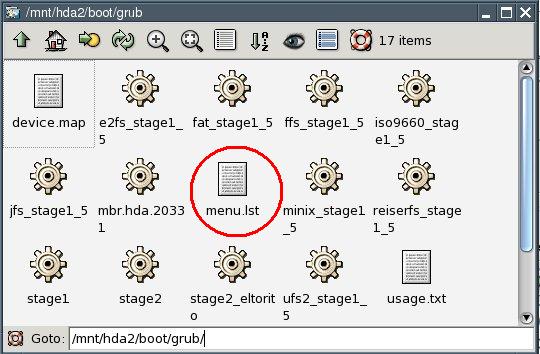
From the context menu that pops up, select "File menu.lst | Open As Text".

You can now see the contents of the menu.lst file.
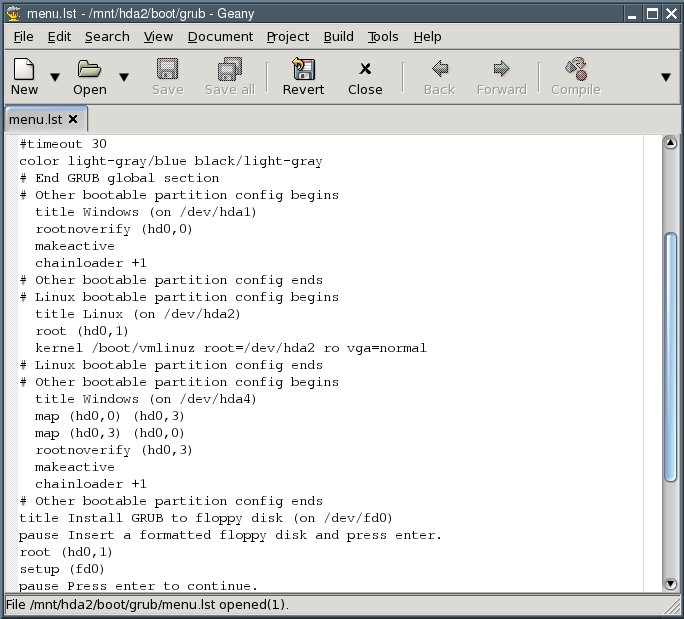
"Comment out", i.e. put a number sign (#) before each of the following lines:

All necessary changes have been made. The file should now look like this:

Save the file by selecting "File | Save" from the program's menu. Exit the text editor.
Close the ROX file manager.
Click on the button "UNMNT" next to /dev/hda2.

The button changes to "MOUNT".

Exit Puppy and reboot the computer: "Menu | Shutdown | Reboot computer".
When you reboot the computer, you will be asked whether you want tosave the "session" (i.e., all the configuration changes you made).Select "DO NOT SAVE" with the cursor keys and hit Return.
Your computer will now shut down completely and then start up again.You will then see the boot loader come up. Select "Puppy Linux (on/dev/hda2)" with the cursor keys and press Return. Puppy boots up. Atthe first bootup, you will once again have to specify your country andyour screen resolution. This configuration is saved so that you do nothave to repeat this process at the next bootup.
如何配置互联网连接(How to setup an Internet connection)
How to setup an Internet connection调制解调器(Modem)
ModemStart off clicking on "Menu | Network | PupDial modem dialup".

Next, enter the information from your provider.
宽带连接(DSL)
DSLFirst you should check if the ethernet-interface was detected.
Start a shell ("Menu | Utility | Rxvt terminal emulator") and enter the following command:
ifconfig

Can you see "eth0"?

If you can not see "eth0" enter the following command:
ifconfig eth0 up

To check if the ethernet-interface is available now, enter the following command:
ifconfig

Now you should see "eth0". Close the shell.
Start the program "Menu | Network | Roaring Penguin PPPoE".

Press the button "SETUP".
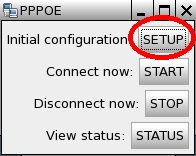
Enter your username (ask your provider), then press the return-key.

Enter the ethernet interface. eth0 is usually correct so you can press the return-key.

At the next question you confirm the default "no" and press the return-key.

Then you have to enter your IP adress. If you get a dynamic IP adress press the return-key only.

Now enter your password (ask your provider).

Enter your password again.

Choose "1" as a "standalone" firewall.
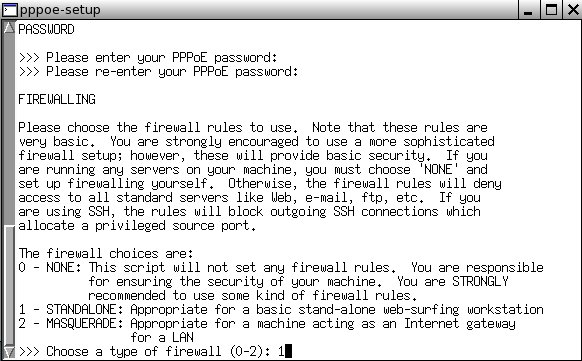
Now you can see your input again. If everything is alrigth press the key "y".

If you want to connect the internet-connection press the button "Start".

A message box opens and you get connected. Press the return-key.

You can now open the Internet browser "Menu | Internet | SeaMonkeyWebbrowser". Enter a URL and see if the Internet site is displayed.
If you want to disconnect the internet-connection press the button "Stop".

A message box opens and you get disconnected. Press the return-key.

路由(Router)
RouterThis chapter is still missing.
无线局域网(WLAN)
WLANTo connect your Puppy to a wireless network take the following steps: Step 1
Click on the "connect" icon on your Desktop, then click "Connect to the Internet by network interface"
.....OR.......
Click on Menu / Setup / Network Wizard

If Puppy recognizes your interface, it will be displayed in the upper portion of the box.
Just click the button for your interface and see step 2 below.
If puppy does not see your interface you will have to load the appropriate module with the Load Module button

If you are unsure, click the "more" tab to Auto-probe drivers, or to install a Windows driver.
After you have loaded the correct module for your interface, it will show up in the first box seen above.
Click on it and proceed to step 2
Step 2
Configuring Network Interface
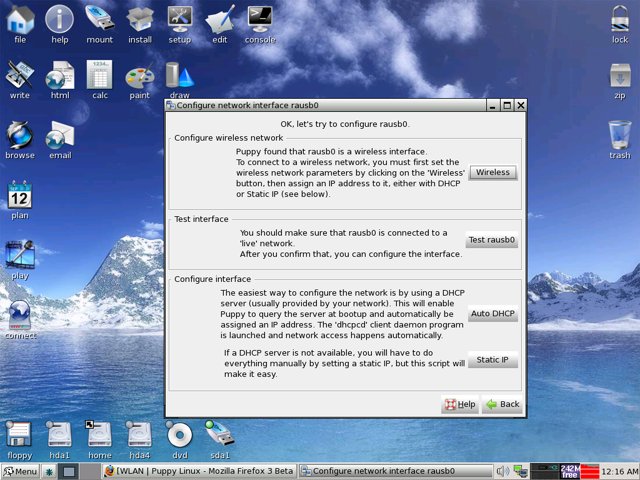
Click the Wireless button

Click Scan ( Or enter the information for your interface if you know it)
Click on your Network from the list that appears . Click Save. Enter your WEP / WPA key if on a secured network.
Then click Use This Profile. Click the Test button to see if Puppy see`s a "live" connection. If it does, then click
Auto DHCP. If successful Puppy will ask you if you want to save the configuration for next boot. Choose yes or no.
Click Done on the box that appears, and you`re all set!
配置电子邮件(How to setup your email-program)
How to setup your email-programStart the program "Menu | Internet | SeaMonkey mail and news". Theconfiguration depends on your email-provider. In the following you willfind an example for GMX.


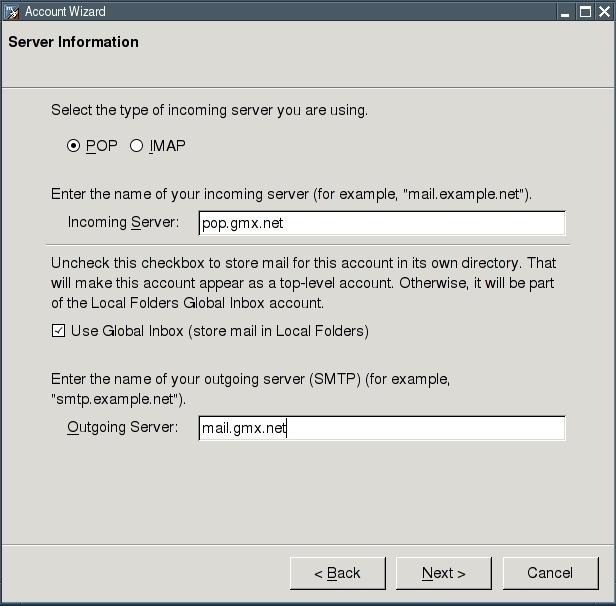



After you press the button "Finish" the program automaticallydownloads your emails from your email account. If you are offline, thefollowing error message appears:

Start an Internet-connection and click (in the Seamonkey-Mail-Programm) on the button "Get new messages".

如何配置硬件(How to set up your hardware)
How to set up your hardware打印机(Printer)
PrinterThis is an easy one to get up and running.Just run "Menu | Setup | Printer Wizard" and the directions there should be sufficient to get most printers working.If your printer is not on the list that comes up try one that is similar for example if you have an superjet 23e try the superjet 23 or superjet 23f.
扫描仪(Scanner)
ScannerThis chapter is still missing.
U盘/外置硬盘(USB sticks / external harddrive)
USB sticks / external harddriveUSB sticks and external harddrives are very simple to use. Start the program "Menu | File managers | Pmount mount/unmount drives" and click on the button "Refresh". Then you click on the USB stick symbol and the file manager ROX will automatically open and show you the files on the USB stick. External harddrives with FAT32-filesystem can be used too. If you changed the file system of the external harddrive e.g. to an ext3-filesystem the program Pmount can not mount the external harddrive. In this case you open a shell and enter:
mount /dev/sdax /mnt/sdax (e.g. for the first partition: mount /dev/sda1 /mnt/sda1)
键盘布局(Keyboard layout)
Keyboard layoutIf you are using Xvesa as your video server and you do not have a US keyboard, you need to customise the keyboard layout. Start "Menu | Document | Geany text editor" and copy the following lines into it for a German keyboard layout.
clear shift
clear lock
clear control
clear mod1
clear mod2
clear mod3
!clear mod4
!clear mod5
!de-latin1.map: German keymap
keycode 9 = Escape Escape
keycode10 = 1 exclam
keycode11 = 2 quotedbl twosuperior
keycode12 = 3 section threesuperior
keycode13 = 4 dollar dollar
keycode14 = 5 percent
keycode15 = 6 ampersand
keycode16 = 7 slash braceleft
keycode17 = 8 parenleft bracketleft
keycode18 = 9 parenright bracketright
keycode19 = 0 equal braceright
keycode20 = ssharp question backslash
keycode21 = dead_acute dead_grave
keycode22 = BackSpace Delete
keycode23 = Tab Tab
keycode24 = q Q at
keycode25 = w
keycode26 = e E currency EuroSign
keycode27 = r
keycode28 = t
keycode29 = z
keycode30 = u
keycode31 = i
keycode32 = o
keycode33 = p
keycode34 = udiaeresis Udiaeresis
keycode35 = plus asterisk dead_tilde
keycode36 = Return
keycode37 = Control_L
keycode38 = a
keycode39 = s
keycode40 = d
keycode41 = f
keycode42 = g
keycode43 = h
keycode44 = j
keycode45 = k
keycode46 = l
keycode47 = odiaeresis Odiaeresis
keycode48 = adiaeresis Adiaeresis
keycode49 = dead_circumflex degree
keycode50 = Shift_L
keycode51 = numbersign apostrophe
keycode52 = y
keycode53 = x
keycode54 = c
keycode55 = v
keycode56 = b
keycode57 = n
keycode58 = m M mu
keycode59 = comma semicolon
keycode60 = period colon Multi_key
keycode61 = minus underscore
keycode62 = Shift_R
keycode63 = KP_Multiply
keycode64 = Alt_L Meta_L
keycode65 = space space
keycode66 = Caps_Lock
keycode67 = F1 F11
keycode68 = F2 F12
keycode69 = F3 F13
keycode70 = F4 F14
keycode71 = at F15
keycode72 = bar F16
keycode73 = dead_tilde F17
keycode74 = currency EuroSign F18
keycode75 = braceleft F19
keycode76 = braceright F20
keycode77 = Num_Lock
keycode78 = Scroll_Lock
keycode79 = KP_7
keycode80 = KP_8
keycode81 = KP_9
keycode82 = KP_Subtract
keycode83 = KP_4
keycode84 = KP_5
keycode85 = KP_6
keycode86 = KP_Add
keycode87 = KP_1
keycode88 = KP_2
keycode89 = KP_3
keycode90 = KP_0
keycode91 = KP_Decimal
keycode94 = less greater bar
keycode95 = bracketleft F11
keycode96 = bracketright F12
keycode98 = Up
!keycode99 = Prior
keycode 100 = Left
keycode 102 = Right
!keycode 104 = Down
keycode 105 = Control_R
keycode 106 = KP_Divide
keycode 108 = Alt_R
keycode 110 = Home
keycode 112 = Prior
keycode 113 = Left
keycode 114 = Right
keycode 115 = End
keycode 116 = Down
keycode 117 = Next
keycode 133 = Alt_L
keycode 134 = Alt_R
add shift = Shift_L Shift_R
add lock = Caps_Lock
add control = Control_L Control_R
add mod1 = Alt_L Alt_R
add mod2 = Mode_switch
add mod3 = Num_Lock
!add mod4 =
!add mod5 =
Save this file as .Xmodmap into the /root directory (please note that the first character of the file name should indeed be a dot). Then restart the X server by selecting "Menu | Shutdown | Restart X Server" (alternatively, you can open a console and issue the "xmodmap /root/.Xmodmap" command). Now the äöüÄÖÜ umlauts are available. The special characters @|~ have been assigned to the function keys F5, F6 and F7 (F7 has to be pressed twice to make the tilde appear). The {}[] brackets are located on function keys F9 to F12.
You can create country-specific keyboard layouts of your own by editing that file. To find out the correct keycodes, open a console and enter the "xev" command. The keycode of any key you press and its assigned character will then be displayed.
如何安装卸载程序(How to install/uninstall programs)
请查看:Puppy 3.01的使用手册中的如何安装卸载程序如何安装卸载程序
安装程序有几种不同的方式,详述如下。在安装前建议备份pup_save.2fs。当你安装中出现错误时就可用备份恢复原样。
How to install/uninstall programs
There are different ways of installing programs which are described below. Before an installation it is advisable to backup the pup_save.2fs-file. So you can restore the file, if something goes wrong with the installation.
[manual] Add section on Slackware
It would be useful to have an up-date on this subject specifically for 4.00, as in section from:
http://www.puppylinux.com/development/package-management.htm
A Slackware package can be converted to PET using the 'tgz2pet' utility. For example:
# tgz2pet xgames-0.2-i386-1.tgz
Which will create 'xgames-0.2-i386-1.pet'. Click on this and PETget
will install it, and will even run the install script inside the
Slackware package.
[manual] rename deinstall to uninstall
Uninstall would be preferable to deinstall. Will renaming this node and the other deinstall node to uninstall cause any structural problems?
如何备份(How to make a backup)
How to make a backup请查看puppy3.01使用手册中的 如何做备份
a starter at filling in the stub
First, what do we wish to back up and what can be safely ignored?
In most cases, one would want to back up user files. These are likely to be in /root or /root/spot. In my case, on my USB sticks, I also have files in /mnt/home (so they are also accessable by computers that I plug the USB stick into outside of Puppy).
The remainder of the file system holds the Puppy distribution (e.g. in /bin, /usr/bin, ...). There is little to be lost in these areas because they are all recoverable from the CD. And you will overtake these with the next release of Puppy anyway. A possible exception is /usr/local/bin (and ~/my-applications for Puppy) which is the traditional place that executable files external to the operating system distribution are stored. But even these are usually recoverable by use of the distribution CDs or another download, so there's little percentage in backing them up either.
The remaining place to worry about is files that control various settings. Some of these are dot files (e.g. .bashrc) in your home directory (/root in the case of Puppy) and files in /etc. In practice, few of these files are so valuable that they cannot be readily recreated -- aggravation perhaps, but usually no serious loss.
Therefore we can confine the areas to worry about backups to those in the first paragraph: the user files.
In unix, there is never just one way to do something. The list of alternatives is indefinitely long. But here are just two ways to do effective backups of your user files:
Open a gftp connection between your Puppy installation and some other computer. Use ssh (the tab in gftp says ssh2) and it should work 'out of the box' with just about any operating system except Windows (which does not natively support ssh). Simply transfer the entire /root/spot/* or /mnt/home/* directories to the archive machine.
Puppy also has rsync capability. There is, as of this writing, GRsync available for download that puts both a memory and a GUI front end onto rsync (so you can repeat the script next week without having to recreate the singularly unmemorable syntax). rsync also runs over ssh. rsync has an advantage over gftp in that it only updates files that have been changed. So if you backed up 101 files last week and since edited three of them, this week's backup will only update the three that you edited and leave the rest undisturbed in the archive. rsync is also easy to wrap into a cron script so it is done automatically at 0300 every Tuesday morning.
(accept this as an outline to get started -- I don't have good example syntax to plug in -- leave that for others).
多用户(Multiuser)
Multiuser请查看puppy3.01使用手册中的多用户
Puppy is not developed as a multi-user distribution. In contrast to other distributions each user has full access to all files, programs and personal data. Nevertheless there are some options for multiusers.
系统安全(Security)
Security即用CD(Live-CD)
Live-CDIf you start Puppy from CD-ROM (or from a CD-image on your harddrive) no potentially harmful programs can install on your computer. With every reboot all potential malware is gone.
However you are not wholly protected against malware while you are online, because (in theory) malware can be installed on your computer and can be active until the next reboot. That is why you should always run a firewall. Besides you can store checksums of all your files to make sure, no one has manipulated your files.
超级用户(Root)
RootIn contrast to most other Linux distributions Puppy does not differentiate between a normal user and the administrator root. Rather you always works as root, which simplifies the use of Puppy. The question arises if it is unsecure to work as root and to have full access to all files, programs and data.
For the normal home user, there are no special risks compared to other Linux distributions. On the contrary, Puppy is probably a bit safer than many other distributions.
First let's analyze the risk of a distribution, which differentiates between user and root. The user works as a normal user, who does not have privileges to write/delete programs and system files. An intruder can compromise only the user’s files. However the intruder has an entrance to the system and can try to gain root-privileges (find the password file, use exploits to transfer malware code and so on), and afterwards try to get access to all files.
As long as Puppy starts from CD-ROM (and is not installed on the harddrive) the program-files and system-files are secure. Everytime you reboot any malware programs, which an intruder could have left, are gone. Of course your own files stored into the pup_save.3fs-file or on a harddrive can be compromised by an intruder, but this can happen to the normal user of another Linux-distribution as well. If you want to be safe from intrusion, store checksums of all files and backup your files regulary.
防火墙与守护进程(Firewall and daemons)
Firewall and daemonsYou should always have an active firewall. It allows you to controlwhat ports your PC uses to communicate with the Internet. Ideally, allports are closed.
Start "Menu | Setup | Linux-Firewall Wizard".

Go to the "default" entry using the Arrow Down key (this option closes all ports) and press Return.

Now you can check the firewall rules. Confirm the default ("Yes") with the Return key.


The line that reads "Performing sanity checks ..." should display "PASSED" now. Press the key you love best ...
... to get to the next dialogue. It allows you to activate the firewall rules.

Confirm the default ("Yes") with the Return key.

The firewall is now active. Hit Return to finish setup.
The "default" option you selected closes all ports. You can specifywhich ports should be left open using the Firewall Wizard's "custom"option. You should only open the ports you really need. If you use acertain port only occasionally, you should open it only when you needit. An open port is usually not a security risk per se. It only becomesvulnerable if your PC is running a service (a so-called "daemon") whichuses that port to listen for incoming requests. This is why you shouldnot run any daemons you do not need on your PC.
This is how to check for which ports are open and which services are running:
Install the Program nmap. Nmap is available as a PETget.
Open a shell and enter:
nmap localhost

This lists open ports. A home user without a home network of her ownshould have no open ports. The X11 service is open because it is theone responsible for the graphical desktop.
The following command gives you a list of which services are listening on which ports:
netstat -anp --ip

This list, too, should be empty except for the X11 port if you are ahome user who does not run a web server or a home network; i.e., noservices (daemons) should be running.
You can test your firewall at the Web site Shields Up!. Load the page and click the Proceed-button.
病毒查杀(Virus scanner)
Virus scannerIf you want to scan your files or a Windows computer you can use F-Prot virus scanner. You can download the program from the Forum. After you have downloaded and installed the program open a shell and enter the following command while you are still online.
/usr/local/bin/xfprot-gtk
or
/usr/local/xfprot/xfprot-gtk
Now you can update the virus definitions. Then you can get offline.Mount your Windows-partition (mount /dev/hdax /mnt/hdax) and make thefollwing settings in F-Prot:

Path to scan: /mnt/hdax
Scan mode: Interactive
Report file: /root/xfprot.log
When the virus scan has finished you can find the log-file at /root/xfprot.log.
If you want to scan another Windows computer, you can remasterPuppy. Boot the Windows computer from the remastered Puppy CD(boot-option puppy pfix=ram) and scan the PC as described above.
入侵检测(Intrusion detection)
Intrusion detectionFor further improvement of your security you should store a checksum (a fingerprint) for all files. At regular intervals, but in any case before a backup, you examine the checksums of your files. If the checksums do not agree, the file was changed or deleted.
In order to compute and store the checksums, you open a shell and enter the following commands:
md5sum /usr/bin/md5sum
Create a checksum of the program md5sum. Write down the checksum.
mount /dev/hda4 /mnt/hda4
Mount the harddrive with your files.
find /mnt/hda4 -type f -exec ls -ail {} \; \-exec md5sum {} \; > /root/check1.dat
Create the file check1.dat with the checksums of all files.
md5sum /root/check1.dat
Create a checksum of the file. Write down the checksum.
If you want to check, which files have been changed enter these commands:
md5sum /usr/bin/md5sum
Create a checksum of the program md5sum. Compare the checksum with the checksum of step (1).
md5sum /root/check1.dat
Create a checksum of the file /root/check1.dat. Compare the checksum with the checksum of step (3).
mount /dev/hda4 /mnt/hda4
Mount the harddrive with your files.
find /mnt/hda4 -type f -exec ls -ail {} \; \-exec md5sum {} \; > /root/check2.dat
Create the file check2.dat with the actual checksums of the files.
diff /root/check1.dat /root/check2.dat > /root/diff.txt
Compare the two files check1.dat and check2.dat. The differences are written to the file diff.txt.
Open the file /root/diff.txt and check, if you know about the changed files. If not think why these files have been changed.
Delete the file /root/check1.dat
Rename the file /root/check2.dat as /root/check1.dat.
md5sum /root/check1.dat
Create a checksum of the new check1.dat-file. Write down the checksum.
用bcrypt加密文件(Encrypt with bcrypt)
Encrypt with bcryptYou should encrypt very sensitive files with the program bcrypt. Bcrypt uses the secure Blowfish-algorithm.
Open a shell and enter:
bcrypt /MyDirectory/MyFile
Then you are asked a passwort (at least eight characters long; you can abort bcrypt with "Ctrl" + "C"). Bcrypt encrypts your file and appends the extension bfe to the file. The original file is deleted automatically.
If you want to encrypt more than one file or a complete directory you should create an archive-file. Start the program "Menu | Utilities | Xarchive archiver". Afterwards you encrypt the archive-file.
Note that bcrypt deletes the original file automatically. You can't recover the file. If you don't want to delete the file start bcrypt with the option -r:
bcrypt -r /MyDirectory/MyFile
If you want to decrypt the file start bcrypt again:
bcrypt /MyDirectory/MyEncryptedFile
Than you enter your password.
For further information see :
Homepage bcrypt
制作自己的Puppy光盘(Make your own Puppy-CD)
Make your own Puppy-CD请查看puppy3.01使用手册中的制作自己的Puppy-CD
You can create your own Puppy-Linux with the following program.
Start the program "Menu | Setup | Remaster Puppy live-CD":

Click on the OK-button.
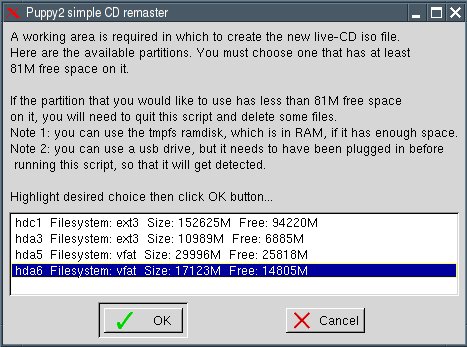
Choose the partition, on which a temporary working directory should be made with the tabulator-keys. Then press the OK-button.

Choose your CD/DVD-burning device with the tabulator-keys. Then press the OK-button.

Insert the current Puppy-live-CD and press the OK-button.
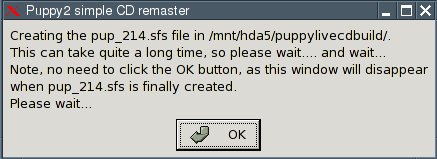
Click on the OK-button.
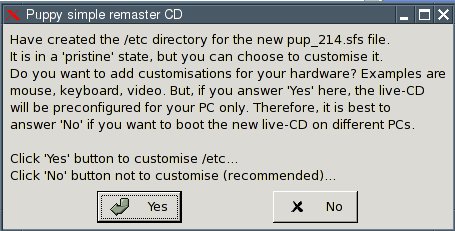
Click on the button "No".

Click on the OK-button.

Click on the button "No".
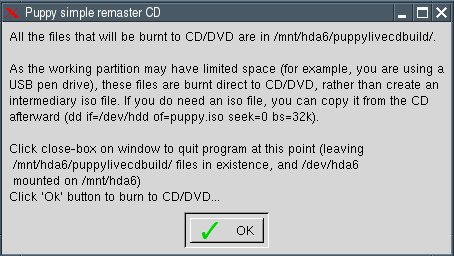
Click on the OK-button.

Take the live-CD out of the CD/DVD-burning device and insert a newCD-ROM or DVD. Choose if you want to create a CD or DVD with thetabulatorkeys. Then click on the OK-button.

Your new Puppy-CD/DVD will now be created. When it has finished, press the Return-key.

Click on the OK-button. Your Puppy-live-CD is now ready.
Windows程序和相应的Puppy Linux程序(Windows-programs and corresponding Puppy-Linux-programs)
Windows-programs and corresponding Puppy-Linux-programsWindows程序和相应的Puppy Linux程序对照表:
| Windows | Puppy-Linux |
| Windows Explorer | ROX |
| Word | Abiword, OpenOffice Write |
| Excel | Gnumeric, OpenOffice Calc |
| PowerPoint | OpenOffice Impress |
| Notepad | Editor Geany |
| Internet Explorer | SeaMonkey Browser |
| Outlook | SeaMonkey Mail |
| Frontpage | Bluefish |
| Photoshop, Paintshop | Gimp |
| mp3-Player | Xmms |
| DVD-Player | Gxine |
提示和技巧(Tips and tricks)
Tips and tricksUpper and lower case
Linux always differentiates between upper and lower case. The two files MyFile.txt and myfile.txt are different file.
Special characters
Do not use special characters except for minus (-) and underline (_) for filenames or directory-names. Don't use the space-character. Use the characters A-Z, a-z, 0-9, -, _ only.
How to move files with ROX
If you left-click on a file and pull it to another directory the file is copied. If you press the shift-key at the same time, the file is moved.
Further inforamtions about ROX
The contextmenu of ROX
To use the contextmenu of ROX right-click on a file or directory.
Copy and paste in the shell rxvt
Copy = left mouse-click
Paste = middle mouse-click
Automatic completion in the shell rxvt
You do not have to type the entire path or filename at the shell. It is enough to type the first letters and then press the tabulator-key. The shell completes the directory-name or filename.
相关链接(Links)
JWM 窗口管理器主页: http://www.joewing.net/programs/jwmJWM 窗口管理器配置: http://www.joewing.net/programs/jwm/config.shtml
ROX 文件管理器手册: http://rox.sourceforge.net/desktop/manual
ROX 文件管理器信息: http://puppylinux.org/wikka/rox
rxvt 脚本信息: http://gd.tuwien.ac.at/linuxcommand.org/man_pages/rxvt1.html
Man-页面: http://www.linuxinfor.com/man-pages-1.htm
脚本命令: http://www.oreillynet.com/linux/cmd
脚本命令:http://www.tldp.org/LDP/abs/abs-guide.pdf
Linux在线指南 http://www.linuxtopia.org
英文原文:
JWM Windowsmanager Homepage: http://www.joewing.net/programs/jwm
JWM Windowsmanager Configuration: http://www.joewing.net/programs/jwm/config.shtml
ROX Filemanager Manual: http://rox.sourceforge.net/desktop/manual
ROX Filemanager Info: http://puppylinux.org/wikka/rox
Shell rxvt Infos: http://gd.tuwien.ac.at/linuxcommand.org/man_pages/rxvt1.html
Man-Pages: http://www.linuxinfor.com/man-pages-1.htm
Shell commands: http://www.oreillynet.com/linux/cmd
Shell commands: http://www.tldp.org/LDP/abs/abs-guide.pdf
Linux online guides: http://www.linuxtopia.org